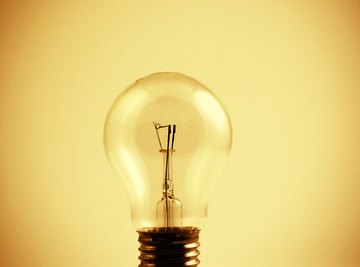
Light bulbs are comprised of a number of nonmetallic minerals and metallic minerals, as well as various other periodic gases and nonmineral materials. Many of these minerals are found in abundance in nature and in the human body. Most minerals must be mined from rock or from the earth’s soil. Minerals are used in light bulbs to make the glass, the mechanism that allows it to light and the fuel to generate the electricity.
Copper
Copper is a metallic mineral substance, and is used in the production of electric light bulbs because it conducts electricity very well. Copper,along with nickel, is used to make the wires that lead into the main body of the bulb. These wires carry electricity from an electric source to the area that emits light, called the filament. Copper must be mined, and is found in nature in several different forms, such as azurite, malachite and cuprite.
Aluminum
Aluminum is a metallic mineral found in abundance in the earth's crust, and according Georgia State University's Department of Physics and Astronomy, aluminum is the third most abundant element found on earth. Aluminum is refined from bauxite ore, and is a good conductor of electricity. Aluminum is used to create the heat deflector in the light bulb so that hot gases do not build up and break the bulb.
Nickel
Nickel is a metallic white mineral used in light bulbs, because it does not corrode. Also, when mixed with iron, nickel creates an alloy that is used to make the inner stem wiring of the bulb. Nickel is used, along with manganese and copper, to make the fuse of the light bulb. A nickel-copper alloy is also used to make some of the light bulb’s electrical wiring.
Molybdenum
Molybdenum is used to make the support wires for the filament in light bulbs. Molybdenum is a metallic mineral that occurs naturally in the earth’s crust and in the oceans. It is very hard and because of this, it is used in tool-steel alloys. Molybdenum is also used in light bulbs because it does not melt easily. Molybdenum is usually found with other minerals in powellite and wulfenite.
Trona
Trona, also known as soda ash, is an evaporite mineral. This means the mineral forms as the result of evaporated water or liquid or through the process of erosion from rock. Along with salt, lime and coal, trona is used to make the glass bulb of the light bulb. Trona is sodium carbonate, and is found in bodies of water that contain soda brine. Trona byproducts include baking soda, some preservatives and some detergents and soaps.
References
- Georgia State University, Department of Physics & Astronomy: Copper
- "Rocks and Minerals"; Herbert S. Zim, Paul R. Shaffer; 1957
- Georgia State University, Department of Physics & Astronomy: Aluminum
- Georgia State University, Department of Physics & Astronomy: Nickel
- Georgia State University, Department of Physics & Astronomy: Molybdenum
Resources
About the Author
Christa Kerley has a B.A. in anthropology with emphasis in archaeology. She also has certificates in geographic information systems and cultural resource management. Kerley was author and distributor of a nonfiction newsletter for several years, and has worked since 1997 as a freelance copywriter and research writer. Some of Kerley's published works can be viewed at eHow, Bukisa, Suddenlyslim.net, Answerbag, and Pluck on Demand.
Photo Credits
light bulb image by Photosani from Fotolia.com
